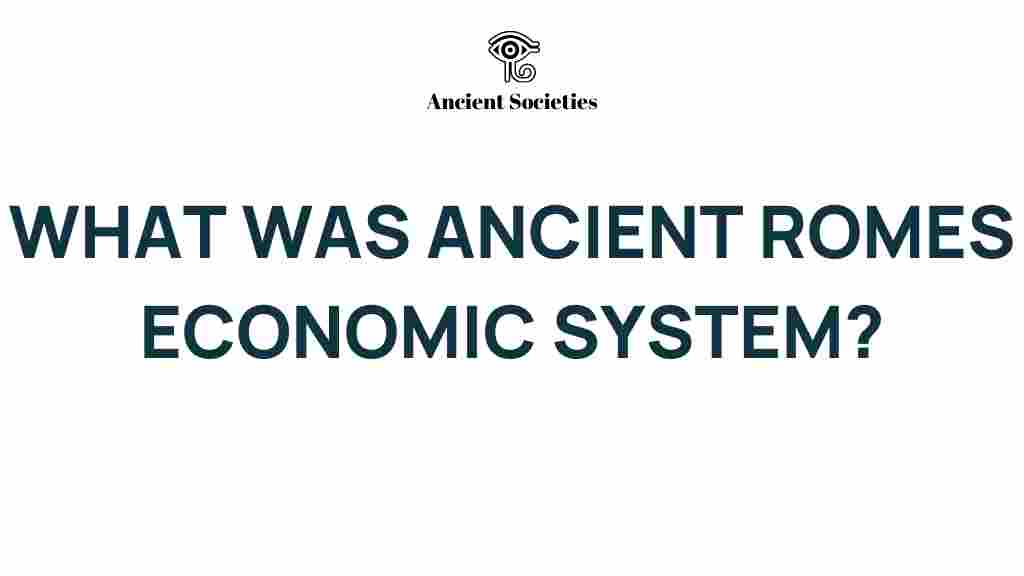Unveiling Ancient Rome’s Economic System: The Backbone of an Empire
Ancient Rome stands as one of the most influential empires in history, with a complex and sophisticated economic system that played a vital role in its expansion and sustainability. This article delves into the various aspects of Ancient Rome’s economic system, examining the key components such as trade, currency, agriculture, and their impact on Roman society and wealth accumulation. Understanding these elements provides insight into how this empire thrived for centuries.
The Components of Ancient Rome’s Economic System
The economic system of Ancient Rome can be broken down into several fundamental components:
- Trade: The lifeblood of the economy, facilitating the exchange of goods and resources.
- Currency: The medium through which transactions occurred, influencing commerce and wealth distribution.
- Agriculture: The backbone of sustenance, providing food for the population and surplus for trade.
- Society: The structure of social classes that determined access to wealth and resources.
Trade: The Lifeblood of Ancient Rome’s Economy
Trade was essential to the prosperity of Ancient Rome. The empire’s strategic location around the Mediterranean Sea allowed for extensive trade routes. Rome engaged in commerce not just within its borders but also with distant lands, including:
- Europe: Goods such as wine, olive oil, and textiles were traded.
- Africa: Grain from Egypt was crucial for feeding the Roman populace.
- Asia: Spices, silk, and other luxury items flowed into Rome, enhancing its wealth.
These trade networks were supported by an extensive system of roads and maritime routes, which facilitated the movement of goods, people, and ideas. The Roman merchant class played a critical role in the economic system, engaging in both local and long-distance trade.
Currency: The Foundation of Commerce
The introduction of a standardized currency was a significant advancement in Ancient Rome’s economic system. The Roman denarius became the primary coin, facilitating trade and commerce. This currency system brought several benefits:
- Simplification of Trade: A common currency reduced the complexities of barter systems.
- Taxation: Currency made it easier for the government to collect taxes, essential for maintaining the empire.
- Wealth Distribution: The use of currency allowed for the accumulation and display of wealth among the elite.
The stability of the currency was crucial; periods of inflation and debasement led to economic distress, demonstrating the importance of a reliable monetary system in sustaining the empire’s economic health.
Agriculture: The Backbone of Roman Society
Agriculture was foundational to the economic system of Ancient Rome. The majority of the population was engaged in farming, and agricultural production was vital for several reasons:
- Food Security: Agriculture ensured a steady food supply for the growing population.
- Trade Surplus: Surplus crops could be traded for other goods, boosting the economy.
- Social Structure: Land ownership was a key determinant of wealth and social status.
The Romans practiced various agricultural techniques, including crop rotation and the use of fertilizers, which increased productivity. Major agricultural products included grains, olives, and grapes. The success of Roman agriculture contributed greatly to the empire’s wealth and stability.
Society and Wealth Distribution
The economic system in Ancient Rome was intricately linked to its social hierarchy. Society was divided into distinct classes:
- Patricians: The wealthy elite who owned large estates and held political power.
- Plebeians: The common citizens, many of whom were farmers, laborers, and merchants.
- Slaves: A significant portion of the labor force, often employed in agriculture and households.
Wealth was concentrated among the patricians, who controlled land and resources. This wealth allowed them to exert influence over political decisions and maintain their social status. The plebeians, while having some representation in government, often struggled economically and relied on the wealthy for employment and resources.
The Role of Commerce in the Empire
Commerce in Ancient Rome was not just limited to trade and agriculture. It encompassed various sectors that contributed to the economy, including:
- Manufacturing: Artisans produced goods such as pottery, textiles, and metalwork.
- Banking: Early forms of banking emerged, facilitating loans and credit for merchants.
- Public Infrastructure: Investments in roads, aqueducts, and ports improved trade efficiency.
The integration of these sectors created a robust commercial environment. The wealth generated through commerce supported public works and military endeavors, further solidifying the empire’s power.
Challenges and Troubleshooting the Economic System
Despite its strengths, the economic system of Ancient Rome faced several challenges that could disrupt its stability:
- Inflation: As the empire expanded, the devaluation of currency occurred, leading to economic uncertainty.
- Overreliance on Slavery: The economy’s dependence on slave labor limited technological advancements.
- Political Instability: Civil wars and power struggles often disrupted trade and agricultural production.
To mitigate these challenges, the Roman government sometimes enacted reforms, such as adjusting tax policies and attempting to stabilize the currency. However, these measures were not always effective, leading to economic decline in later years.
Conclusion: The Legacy of Ancient Rome’s Economic System
Ancient Rome’s economic system was a complex and multifaceted structure that played a crucial role in the empire’s rise and fall. From thriving trade networks to a standardized currency and robust agricultural practices, each element contributed to the empire’s wealth and societal organization. While the system faced significant challenges, its legacy continues to influence modern economic practices.
Understanding Ancient Rome’s economic system provides valuable insights into how societies can develop, sustain, and sometimes collapse due to economic pressures. For those interested in further exploring the intricacies of Ancient Rome, consider visiting this resource for more historical context.
In summary, the economic system of Ancient Rome was indeed the backbone of an empire, shaping its society, culture, and ultimately its destiny.
For additional reading on economic systems in history, check out this informative article.
This article is in the category History and created by AncientSocieties Team
